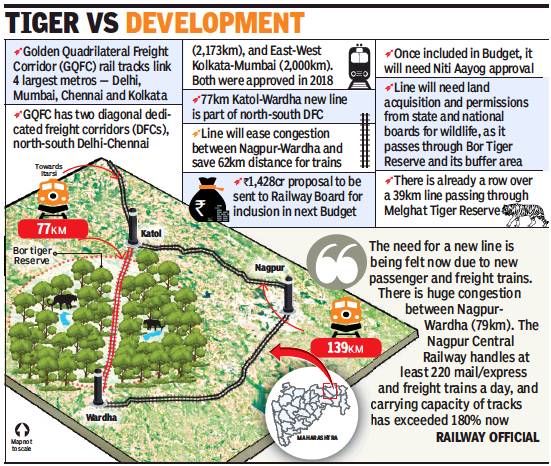Bor Tiger Reserve
This is a collection of articles archived for the excellence of their content. |
Katol-Wardha railway line
Status in 2018

From: Vijay Pinjarkar, Rail line through Maha tiger reserve stirs hornets’ nest, September 17, 2018: The Times of India
Even as protests against upgrade of the railway line through Melghat Tiger Reserve (MTR) are yet to die down, the Central Railway (CR) has approved a proposal for a new 77km line between Katol and Wardha. If constructed without any mitigation measures, the line will cut Bor Tiger Reserve (BTR) into two parts.
With 139sqkm core area, Bor is the country’s smallest tiger reserve with presence of seven tigers and over 200 bird species, and hundreds of herbivores. The tiger reserve’s buffer comes to 670sqkm and the railway line, if allowed without any mitigation measures, would spell doom for wildlife and ecology, and shatter source population of big cats.
The corridors connecting Bor to other forests have already been cut by four-laning of roads in corridor patches of Bazargaon-Kondhali-Talegaon (NH6), Nagpur-Chandrapur (NH7) and Butibori-Wardha and Hingni-Selu state highways.
“Now, Nagpur-Mumbai Samruddhi Expressway is in the pipeline, where MSRDC has shown commitment for wildlife mitigation measures while others (agencies) are blatantly violating guidelines. The new line will isolate tigers and wildlife, and man-animal conflict will flare up,” said Bor officials.
The Rs 1,200-crore (old cost) Katol-Wardha line project was announced in 2009-10 railway budget, and the survey was done in 2011. Since then the proposal had been pending. “The plan was discussed at length at a meeting in Mumbai on September 5 and approved by general manager DK Sharma. The revised Rs 1,428-crore plan will be submitted to the railway board for inclusion in the next budget,” senior railway officials told TOI.
As the plan has been prepared by the headquarters, there is no information whether wildlife mitigation measures have been included in the project. Nagpur DRM Somesh Kumar was not available for comments. Chief public relations officer Sunil Udasi could not come up with an immediate response on the issue.
The new line will be part of the Golden Quadrilateral Freight Corridor (GQFC), which has six dedicated freight corridors (DFCs). The new line falls in the North-South DFC (2,173km) from Delhi to Chennai, which was approved in 2018.
“The need for a new line is being felt now due to new passenger and freight trains. There is huge congestion between Nagpur and Wardha (79km). The Nagpur CR handles at least 220 mail/ express and freight trains, and carrying capacity of tracks has exceeded 180% now,” said railway officials.
The railway distance between Katol and Wardha is 139km. If the 77km new line is laid, the railways will save on time and money for 62km and there will be faster train movement as freight trains will bypass Nagpur and land straight at Sevagram before heading towards south.
This will also pave the way for smooth train movement between Itarsi and Wardha via Nagpur. “On a daily basis, the CR here receives at least 18 freight trains from Itarsi-end and dispatches 15 trains. Despite the third and fourth lines between Nagpur and Wardha, the new line will be needed for future requirement of growing cities and towns,” railway officials said.